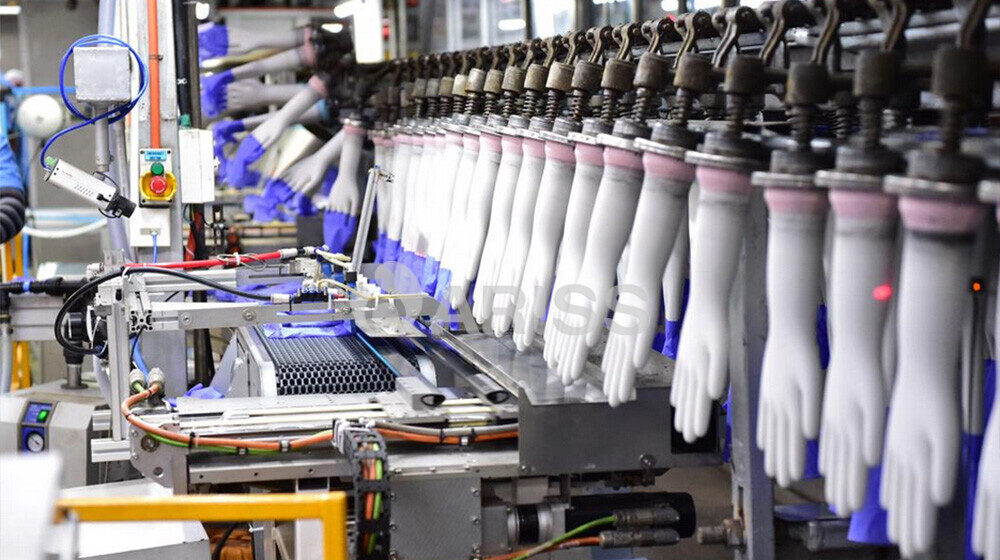Nitrile Gloves
There’s no doubt that nitrile gloves are considered the more specialist version of latex gloves, and that’s because they’re not made from latex rubber at all, but instead a synthetic, artificial rubber solution that provides a whole range of benefits.
If you’re looking for gloves that can stand their ground against the most challenging and most intensive of tasks but remain agile enough for more concise tasks, nitrile gloves will be at the top of your list of considerations. In this section of the book, we’re going to be breaking down what exactly nitrile gloves are used for, the history behind them, the benefits they provide, and everything you need to know about the markets of the world.

What are Nitrile Gloves?
Whereas latex gloves are made from natural rubber, nitrile is the name given synthetic rubber. These glove types have grown massively in popularity over the years. Namely, this is because latex allergies exist, meaning that users with allergies won’t use traditional latex gloves without issue. This is important in all businesses, from people working with machines to especially people working in medical practices where members of the public are involved.
Although latex allergies are relatively uncommon, affecting less than 1% of people in the US, reported data shows that the average worldwide sits between 2% and 3%.
Those with the highest risk factors are people who;
- Live with Spina Bifida
- Undergo multiple surgeries
- Have a family history of allergies
It’s good to have nitrile gloves on standby so you can still provide PPE solutions as a responsible business should.
That’s not to say that both latex and nitrile gloves aren’t similar. On the contrary, both glove types hold many of the same benefits, such as being strong, resistant to tears, elastic, available in a range of sizes, and can provide a high degree of protection to the wearer.
However, the anti-allergy properties will appeal to some customers, businesses, and buyers.
The Benefits and Characteristics
It’s becoming common knowledge that nitrile gloves are a bit of a step up from latex gloves and are becoming the more common solution in industries worldwide and for many reasons. So let’s take a look at those benefits as well as some of the characteristics now.
All the Benefits of latex gloves and more
There’s no doubt nitrile is more resilient than latex, thus being able to pride themselves on being tougher, more long-lasting, and providing a high-quality level of protection.
This is apparent in how resistant nitrile is against temperatures and moisture, especially when dealing and working with substances like oils, fats, chemicals, and solvents. This gives nitrile gloves the leg-up in many industries as being the most preferred glove and PPE option.
Since these gloves are produced using optimized production methods and synthetic compounds, they tend to be more tear and rip-resistant (meaning they’re more durable in many applications), and they are, therefore, safer to use for more extended periods without having to change them over to a new pair.
They also have a longer shelf life than latex gloves (nitrile lasting an average of five years, whereas latex gloves have an average lifespan of around three to five years), meaning they can sit in warehouses or storage for longer, or in the logistics process, without losing their integrity.
Extra Security for the User
Perhaps one of the more unknown benefits of using nitrile gloves is that when these gloves break, they break. With latex gloves, when they tear or fall victim to a puncture hole, they might break apart slowly over time, meaning you can pretty much keep using them for a little while after.
However, this is unacceptable in many professional industries because you need to uphold the highest degree of safety and protection to avoid contamination, infection, or injury. This is why when nitrile gloves tear or receive a puncture wound; they will quite literally break up and start to fall apart.
This is an intended feature. When these gloves take damage, the user is quickly alerted that the damage has occurred and can then switch to a new pair of gloves as soon as possible, ensuring safety is maintained in the best possible way.
An Ideal Solution in Many Environments
Nitrile gloves are a great solution in many situations, and this versatility makes them very popular. Statistics show that in 2019, 69.4% of all nitrile gloves were used in the medical and healthcare industries, thanks to their ability to prevent cross-contamination of harmful pathogens.
However, their uses don’t stop there. Nitrile gloves are the most common form of glove used in the automotive and vehicle industries thanks to their durability and reduced friction when handling parts. They are also incredibly resistant to grease, oil, and petrol/gasoline, making them the ideal fit.
It even goes further than that. In countries like Australia, workplaces promote the use of special black nitrile gloves that not only provide all the benefits nitrile gloves are known for, but due to their color and substance-resistant nature, they’ll ideal in hot countries because they even help to reduce the impact of sweat while in use.
This kind of attention to detail makes nitrile gloves such a good choice when it comes to PPE.
Of course, these benefits and properties transfer to their domestic counterparts, meaning homeowners and public members will opt for these gloves when working on their projects, like working on their car, in the garden, or cleaning their homes.
The Downsides of Nitrile Gloves
While there are many benefits, it would be irresponsible not to discuss the disadvantages; fortunately, there aren’t too many. Perhaps the most obvious is that nitrile gloves are a little more expensive than their latex counterparts.
What’s more, nitrile gloves are pretty universal but aren’t ideal in all industries. For example, nitrile gloves tend to be kept out of food production processes. Although there are some brands and designs that safety authorities have cleared, many haven’t, mainly because latex gloves are better. As a business, it’s always important to check whether your chosen nitrile gloves have been certified for food processing in this way.
The Market for Nitrile Gloves
Since the rise of the COVID-19 pandemic and the focus on safety and optimized PPE within the business world over the last decade, there’s been a massive spike in demand for nitrile gloves. Studies and research, such as the Global Examination Nitrile Gloves Sales Market Report 2021, found that the nitrile glove market was valued at around $8 billion back in 2020.
However, at the current growth rate (CAGR) sitting at 9.65% (as of April 2021), the industry is expected to grow, which is a massive increase, creating a ton of opportunities for businesses of all nature and all over the world, including buying, selling, logistics, and manufacturing.
Powder-free gloves remain the most popular form of gloves, by far, making up around 80% of the total nitrile and latex glove market.
Reports also state around 69.4% of all nitrile gloves were used in the medical and healthcare sectors as of 2019, as we mentioned before, and this surely grew with the rise of COVID-19. Although this may have been a one-off event, this is now the world we’re living in, so while the numbers and statistics have shifted dramatically over the last two years, they are still an important indicator of what the future looks like.
Summary
For people, businesses, and operations willing to spend a bit extra while taking their PPE efforts seriously, nitrile gloves will always be a good choice. Nitrile gloves are strong, durable, hard-wearing, and offering the ultimate level of protection.
With a growing industry and a ton of interest in this variety, there’s little doubt in anyone’s mind that nitrile gloves are still good in the market.
Kim Gloves is a certified manufacturer of nitrile gloves in Thailand and we produce gloves for a variety of industries. Contact us now to receive more information and get your quotation.
